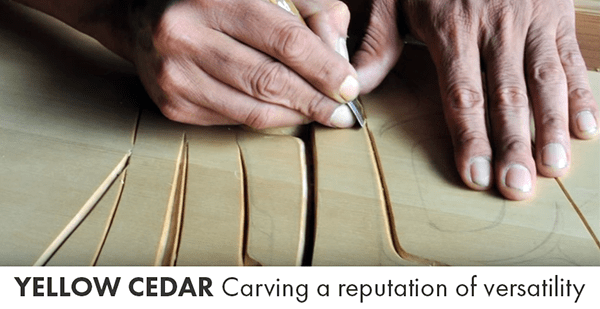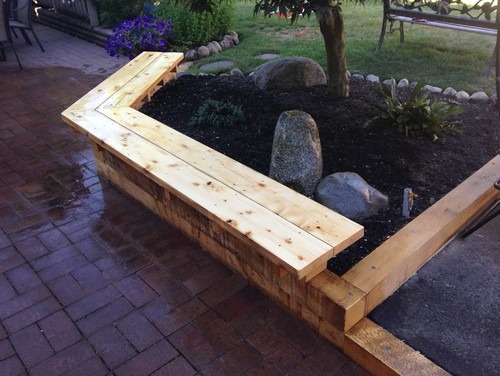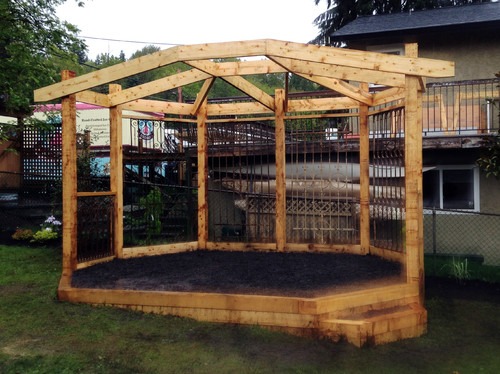Yellow Cedar grows along British Columbia’s coastal region. It is a medium-sized tree growing up to 24 metres tall and 90 cm in diameter when mature. It often grows singly or in small clumps in a mixture with conifers such as amabilis fir and western hemlock. It is a beautiful tree that is tough, strong and extremely durable. [source]
Species Characteristics
Yellow Cedar is valued for its strength, extreme durability and outstanding beauty. It is renowned for its distinctive, uniform yellow colour, fine texture and straight grain. Because it is considerably harder than most commercial softwoods, it has excellent strength and wear properties.
Common Uses
Species Characteristics: Yellow Cedar is valued for its strength, extreme durability and outstanding beauty. It is renowned for its distinctive, uniform yellow colour, fine texture and straight grain. Because it is considerably harder than most commercial softwoods, it has excellent strength and wear properties.
Uses: Yellow Cedar is ideal for a broad range of uses where strength and durability are top concerns, especially for environmentally sensitive projects where pressure-treated lumber cannot be used. At the same time, the high workability of Yellow Cedar makes it ideal for carving and custom projects where the final appearance is a key consideration.
Why is Yellow Cedar ideal to work with? Yellow Cedar adds beauty, elegance and prestige to any project. This highly prized wood of uncommon appearance is admired for its distinctive, uniform yellow colour and its fine texture and straight grain. When freshly cut, the wood is pleasantly aromatic — adding another unique element to this special wood. Yellow Cedar is found only on the west coast of North America.
Sustainability Considerations: Yellow Cedar is the right choice for the environment. [source]
Yellow-cedar is one of the world’s most durable woods with exceptional longevity. Due to this attribute it is used for shingles, posts, poles, marine pilings, small boat hulls, oars and paddles, water and chemical tanks, exterior doors, and window boxes. Structural grades are commonly used for exterior applications such as bridges, decking, stairs and for landscaping.
It is sometimes used in specialty construction projects such as temples and shrines. Unlike most softwoods, density across single growth rings is quite uniform making this a very good carving and woodworking species. This effect also accounts for the lack of visual grain. This wood is incredibly easy to work and, therefore, is prized for applications such as joinery and carpentry, decorative paneling, furniture, mouldings and cabinetwork. Its fine, even texture makes it a top choice for carvings and turnings.[source]
Y E L L O W – C E D A R
Botanical Name: Chamaecyparis nootkatensis (D. Don) Spach
Sometimes known as Yellow Cypress or Alaskan Yellow Cedar
Yellow-cedar lumber is often sold green due to its unique properties. When dried, lumber is dried according to end-use and customer specifications. Kiln drying inhibits natural staining of the wood, improves its strength and stiffness, enhances its appearance, and increases its resistance to decay and attack by insects. [source]
Working Properties
Yellow-cedar is considerably harder when dry than most commercial softwoods so it is strong. It is known for its exceptional working properties and can be easily machined and finished. It turns, planes and shapes well and can be sanded to a smooth finish. The wood glues satisfactorily, has moderate nail and screw holding ability, and takes a good finish.[source]
Follow POCO Building Supplies’s board Yellow Cedar Carvings on Pinterest.
Commercial Availability
In North America structural grades are in accordance with the National Lumber Grades Authority (NLGA) rules for dimension lumber. Yellow-cedar is currently marketed under the Northern Species group making its official structural design value lower than SPF, Hem-Fir, or DFir-Larch. However, yellow-cedar is used structurally for its appearance and for its decay resistance. Yellow-cedar is commonly produced in appearance grades according to NLGA rules. Clears, shop lumber and moulding stock are most common. Yellow-cedar is also offered in export grades for Japan and other markets. [source]
We currently have a very nice grade of 2×8 Kiln-Dried Yellow Cedar Rough Stock. The product is net 2-1/4″ Thick by 8-1/4″ wide and available in a variety of lengths from 8′ – 20′. We also supply Yellow Cedar Decking (available by Special Order) and also full dimension 5×5 Yellow Cedar Posts which are ideal for fencing, landscaping and gardening.






